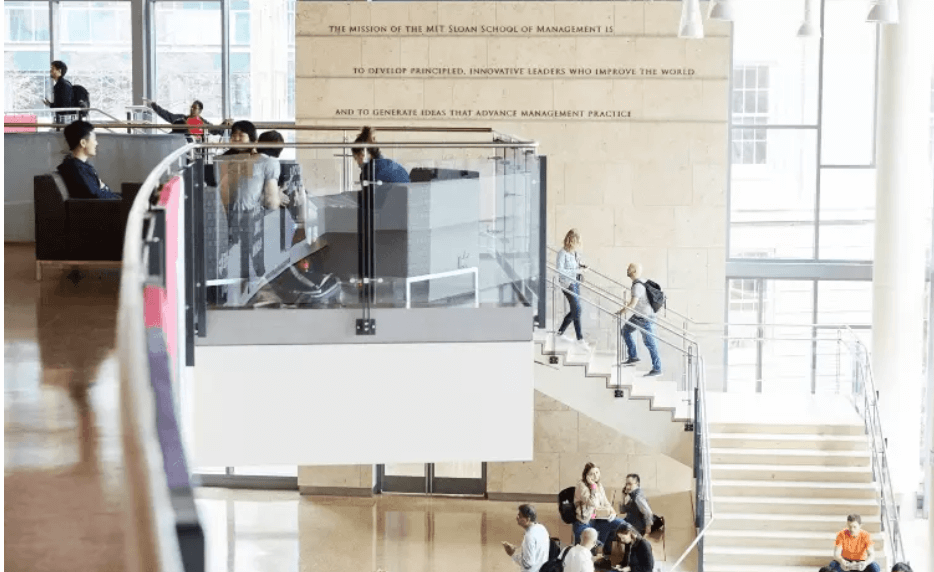MIT Sloan School of Management is the business school of the trailblazing Massachusetts Institute of Technology (MIT)—and the MIT MBA class profile of 2026 lives up to the school's reputation.
Studying an MBA at MIT Sloan is a clear route to career success—90% of the MIT MBA class of 2024 received full-time offers within three months of graduation with a median base salary of $170k.
The MIT MBA has produced scores of famous alumni in the world of business, including HubSpot CEO Brian Halligan, president of basketball operations for the Philadelphia 76ers Daryl Morey, and ex-CEO of Citigroup John Reed.
So, who are the students pursuing their MBA at MIT Sloan today? Where are they from and how do you compare?
MIT MBA | Class overview
The MIT Sloan MBA class for 2026 is made up of 433 students. The students who did secure a place on the program can count themselves fortunate—the MIT MBA has an acceptance rate of just 17.8%.
Students join the Sloan cohort from a variety of industries. For the class of 2026, 30% were working in consulting pre-MBA, 21% came from a tech background, and 20% came from financial services.
MIT MBA | Class diversity
The MIT MBA class of 2026 profile is made up of students from 53 different countries, with an international student ratio of 40%. 33% of the class are Asian American, 4% are African American, 10% are Latinx, and 47% are white.
In 2024, the MIT Sloan MBA increased its share of female students once again; 49% of the class of 2026 are women, meaning it has the second-highest level of gender equality among the M7 business schools (only Kellogg currently has gender parity).
It’s easy to see why Sloan is leading the way when it comes to gender equality. The prominent MIT Sloan Women in Management club aims to encourage women to pursue leadership roles while creating a network of women who can thrive professionally. Sloan is also a Forté partner school, meaning female students can gain support via Forté scholarships.
In addition, there is the Sloan Pride Club, which endeavors to celebrate and strengthen the LGBTQ+ community at the school. Alongside this, MIT is a participant in the Reaching Out LGBTQ MBA Fellowships program.
Representation in the MIT MBA classroom
MIT MBA | GMAT Scores
As of early 2024, the GMAT exam structure and scoring system have been updated. Although scores continue to be given in 10-point increments, the new scale spans from 205 to 805, replacing the old range of 200 to 800.
The median MIT MBA GMAT score under the previous scoring system was 730, with the middle 80% of scores falling between 690 and 760.
The median GMAT score for the MIT MBA therefore equates to an approximate score in the range of 675-685 under the new GMAT scoring system. Check out average GMAT scores for the world’s top MBA programs.
The GRE quant range was 159-170 and the GRE verbal range was 157-168.
MIT MBA | Undergraduate Major and GPA
The MIT MBA class of 2026 came from a broad range of undergraduate majors, with 29% coming from a major in engineering, 22% coming from business, and 15% from economics. It’s no surprise that so many people go from engineering to an MBA at Sloan, as MIT is famous for being an engineering hub.
This year’s cohort also completed undergraduate majors in areas such as computer science (9%), science and math (8%), and social sciences (6%).
The average undergraduate GPA for the class was 3.7.
READ: 10 Famous MBAs From Sloan School of Management
(c) MIT Facebook
MIT MBA | Work Experience
As a prominent institution in the tech and science world, it’s perhaps unsurprising to see that 20% of the MIT Sloan MBA class of 2026 worked in technology before joining the program. Similarly, 6% came from the pharmaceutical, healthcare and biotechnology industries.
However, consulting and finance make up a larger slice of the class—51% in total—proving that these two industries continue to be a fertile breeding ground for top-level MBA students and graduates.
Other industries represented in this year’s MIT MBA class include government and non-profit (10%), consumer products/retail (5%), and media and entertainment (2%).
On average, MIT MBA students have five years of work experience prior to joining the 24-month program.
Pre MBA industries: MIT MBA

Earning a spot in the MIT Sloan MBA takes a lot of hard work. You’ll need a good GMAT score and leadership experience to be admitted.
But if you’re committed to joining a well-rounded cohort and experiencing a diverse and exciting learning environment, the hard work is worth it.
Although students with a background in finance and consulting make up the bulk of the MIT MBA class, applicants are welcome from all industries—a non-traditional background may even help you stand out.
Sloan is an especially good choice if you want to join the Massachusetts tech ecosystem, which is populated by rapidly growing startups.
At the same time, MIT MBA grads achieve success in multiple industries with MIT's notable alumni making waves in technology, sport, finance, and more.




